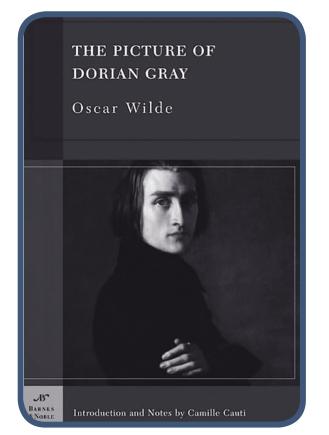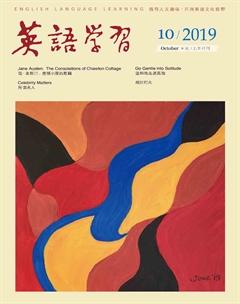所谓名人
By Holly Grout

In his novel The Picture of Dorian Gray (1891), Oscar Wilde teased: “There is only one thing in the world worse than being talked about, and that is not being talked about.”When he wrote those words, Wilde was at the pinnacle of his fame—and the beginning of a romantic scandal that would make him infamous.1 Frequently disparaged but equally admired for his provocative prose and flamboyant posturing, it is not surprising that Wilde would attract public attention by his controversial love affair with Lord Alfred Douglas and his impassioned courtroom defence of “a love that dare not speak its name”.2 It was not the first time, nor would it be the last, that Wildes larger-than-life personality eclipsed his professional reputation.3 One of the periods most eccentric, charismatic and recognisable figures,4 Wilde experienced fully the privileges and perils of being talked about. That is to say: Wilde knew well the power of celebrity.
現代社会,名人似乎已经成为生活中不可或缺的一部分。他们是茶余饭后的谈资,是选择商品的参考,甚至是粉丝们划分敌友的依据。然而,究竟是从何时起,名人成了一种理所当然的存在?我们在对名人的仰望和窥伺中,又隐藏着怎样的期许和情怀呢?
And what is that? Why do we think of Wilde as a celebrity but not, say, Sir Isaac Newton? What exactly is celebrity, and when did celebrity as we know it emerge?
Some scholars have located the birth of celebrity in the late-18th and 19th centuries. They have argued that it was this period that not only produced exceptional personalities but also provided the structural conditions necessary for facilitating the development of a fully realised celebrity culture. Reflected in the new field of biography, the pzopularity of portraiture, the proliferation of memoirs, and the appearance of human-interest stories and obituaries in daily newspapers, this period fostered a new concept of the “self” that championed the individual.5 With an expanding public sphere, where more people than ever before could read and take part in the public conversation through the breakdown of entrenched6 political and social hierarchies, any individual (theoretically at least) could aspire to greatness. Ordinary men and women were increasingly aided in this venture7 by technological innovations that stimulated new modes of communication, such as the introduction of largescale print culture and image reproduction, as well as by the forces of industrial capitalism that initiated widespread urbanisation, mechanised work and time, encouraged the commercialisation of leisure, and generated new forms of status.
Famous individuals had long gained recognition within conventional centres of influence such as courts, salons and the ivory towers, and for centuries their likenesses were reproduced in book engravings, in sculpture, on medals and coinage, and in ceramic figurines.8 But these images circulated primarily among the elite, who could afford to purchase and collect them. Mechanised production democratised access to such images. By the late-19th century, anonymous spectators and faceless consumers (as opposed to patrons and close friends) encountered images of the exceptional in newspaper caricatures, on porcelain cameos and inexpensive pocket portraits, on stylised photo cards, and life-sized posters that plastered urban boulevards and decorated major thoroughfares.9
The same urban, mechanised age that threatened to alienate the individual also brought strangers closer to one another than ever before. Not only was it literally easier to be seen—on the streets, in new spaces of leisure10, in the ever-expanding visual culture of photographs and newsprint—it also became easier for individuals to become known. Filtered through the media and often curated11 by the public figure herself, the image was carefully stylised, intended to promote not necessarily the person but the personality. This personality, in turn, became the brand through which the previously unknown individual would become known to larger, even more anonymous publics.
Perhaps no one mastered the phenomenon of creating and publicising 19th-century personalities more effectively than the American showman P. T. Barnum. A clever entrepreneur and shrewd promotions man, Barnum used his museums, circuses and travelling-company productions to launch the careers of newcomers such as the two-foot-tall“General Tom Thumb” and the opera singer Jenny Lind, whom he billed12 as “the Swedish Nightingale”. Rather than focus solely on talent, Barnum exploited Thumbs small stature and showcased Linds sweet temperament and foreignness. He then used the media to transform both performers into international sensations—into celebrities.
Through various forms of mediated representation, audiences gained unprecedented13 access to the secret lives of public figures. This access cultivated the false familiarity between the public figure and her audience that would later become the cornerstone of modern celebrity culture. As public figures became increasingly “known”, through gossip journalism, manufactured publicity and product endorsement14, as well as through the mass circulation of their images and stories, they also became marketable commodities in their own right. In this role, audiences could not only get to “know” a famous person, they could purchase, consume and possess a piece of her as well.
Many scholars have used the point that celebrity requires consumption to argue for its origins in the 20th century. However, all the essential features of celebrity culture were developed in the 19th: look at Barnums promotion of “Lindomania” (predating Beatlemania by about 100 years), the popularity of collecting and trading portraiture cards, or the celebrity endorsements of a growing number of products, from tea and mustard to cosmetics and hair creams, all accompanied by testimonials and images of recognisable public figures.15 Locating the birth of celebrity in an earlier period marks a significant point of departure from much late-20th-century scholarship that correlated celebrity with cinema, and aligned it with the emergence of the Hollywood star. The 19th century set the stage for modern celebrity; the 20th century, through the mass media, amplified16 celebrity beyond all expectation. Hollywood did not invent celebrity; it simply gave us more of it.
Whereas many megastars seem beyond our reach, some of them seem more authentically like us. The down-to-earth girl next door(Jennifer Aniston or Meg Ryan) or the dependable good guy (Will Smith or Ryan Gosling) make us believe that perhaps we too can possess a certain star quality.17 Through press coverage of their personal lives (from marriage and divorce to success and scandal; from what they eat and where they shop to whom they know) and the commercial distribution of intimate photographs, personal memoirs and sensationalised tabloid exposés we learn that all of these celebrities, no matter how bright their star, are also “just like us”. They are simply ordinary men and women who through luck, grit and circumstance transformed themselves into someone or something special.
In the 21st century, the media offers audiences greater access to information about public figures (increasingly, in real time) thus advertising the celebrity, boosting her visibility and confirming her relevance. The featured celebrity, in turn, generates revenue for media corporations and ensures the viability of websites by increasing the number of “clicks”. Moreover, through the media, the celebrity is packaged as a particular type—a trendsetter, a role model, a rebel, a mirror for the status quo—becoming both a cultural broker and a social force in the process.18 In this role, the celebrity plays simultaneously to collective fantasies and to individual desires, she stimulates the imagination but also invites vicarious identification, she elicits intrigue as an object of curiosity, she courts familiarity despite her distance from her audience, and she reasserts her exceptionalism even as she appears to be just like us.19
Moreover, in the era of reality TV casts, social-media influencers, YouTube personalities, bloggers, vloggers and Instagrammers, it would seem that anyone might become, in Daniel J. Boorstins perhaps prophetic words,20 “known for their knownness”. Indeed, whether we regard ourselves as indifferent publics or eager spectators, by continuing to debate which bodies are worthy—whether by endeavouring to keep up with or preferring to keep away from the Kardashians—we remain entangled in celebritys snare.21 Whether we like it or not, those fascinating, reproducible individuals known, if only for their knownness, continue to give us something to talk about.
But why do we need something or someone to talk about in the first place? Where does all this talking get us? What does our fascination with celebrity reveal about how we see ourselves? Perhaps a celebrity might help us grapple22 with these questions. In her acceptance speech for Best Actress Oscar for the Johnny Cash biopic Walk the Line (2005), Reese Witherspoon said that shes simply trying to “make work that means something to somebody”.23 Perhaps celebrities matter so much to us because, like Witherspoon, we all want nothing more than to matter.
王爾德在他的小说《多里安·格雷的画像》中打趣说:“被人议论固然可怕,但更可怕的是无人问津。”在写这句话的时候,王尔德正如日中天,但不久后,他就将陷入一场桃色丑闻并因此声名扫地。他的文风汪洋恣肆,为人风流倜傥,难怪总是既让人爱,又招人恨。他与道格拉斯勋爵沸沸扬扬的恋情,还有法庭上那场对“不敢言明之爱”的激烈辩护,将他推到了舆论的顶峰也不足为奇了。像这样的逸事还不止一桩,以至于比起他的文学成就,王尔德极富传奇色彩的其人其事更加让人津津乐道。作为那个时期张扬不羁又极富魅力的名人,王尔德充分感受到了舆论带来的利与弊。换言之,他最了解名人的力量。
那么,名人究竟为何?为什么王尔德是名人,而牛顿却很难归入名人之列?究竟什么是名人?我们所知道的名人这个概念又是何时产生的呢?
有学者认为,名人的概念诞生于19世纪晚期至20世纪。他们认为那是一个个性张扬的时期,创造名人文化的土壤也逐渐成熟。传记有了新的写法,肖像摄影开始流行,回忆录逐渐泛滥,报纸开始登载有人情味的故事和记载生平的讣告——“自我”这个概念形成了,使得个体的旗帜更加高扬。曾经根深蒂固的政治社会等级制度土崩瓦解,公共领域迅速扩张,越来越多的人学会读书写字,参与到公共讨论中来。甚至可以说,任何人(至少在理论上)都有可能成就一番伟业。大规模的印刷、图像复制等技术革新带来新的传播方式;而工业资本主义的兴盛,则大大推进了城市化的进程,让机器进入工作和生活,孕育出休闲娱乐产业,也刷新了阶层的划分方式。这些都让平头百姓也可能天下闻名。
过去名人的知名度依赖宫廷、沙龙和学术机构这些传统的影响中心而建立,几个世纪以来其形象则靠图书版画、雕塑、图章硬币和小瓷像传播。这些物件主要在富人阶级中流通,也只有他们才买得起、放得住。而机械化的大规模生产则使得原本王谢府里才能见到的藏品也飞入了寻常百姓之家。到了19世纪晚期,报纸上的漫画、瓷制的浮雕小徽章、廉价的口袋肖像画、风格类似的小卡片,还有街上张贴的大幅海报上,随处都能看到名人的肖像,它们原本只有名人的资助人、密友可以拥有,如今则被匿名的观察者和面目不清的消费者所取代。
城镇化和机械化一方面让原本亲密的人变得疏远,却又前所未有地拉近了陌生人间的距离。大街上、新的娱乐场所里,还有逐渐普及的照片和报纸上,随处都可以见到陌生的面孔,想要名扬四方也容易得多。通过媒体的过滤和公众人物自身的挑选,这些形象仿佛一张张程式化的脸谱,旨在宣传的并非是人物本身,而是其身上的某种特质。人物特质反对来又被打造成一个招牌,招牌之下,曾经的无名小辈也能变得家喻户晓。

20世纪,炮制和推广公众人物是项技术活,而美国娱乐之王巴纳姆或许正是这方面首屈一指的专家。这位创业家兼公关大牛,靠着自己创办的博物馆、马戏团和巡演公司,一手捧红了侏儒人“拇指汤姆将军”和女高音林德女士。他还给林德取了个雅号,叫“瑞典夜莺”。他展出的不仅是二人的才艺,而且还利用侏儒人的身形和林德的甜美性格与异域风情大做文章。在他的宣传运作下,两人都成了轰动世界的名人。
经过媒体全方位、多角度的呈现,观众得以一窥公众人物的私密生活。而这让公众人物和观众之间形成了一种虚假的熟悉感,这种熟悉感即是培育当代名人文化的奠基石。八卦小报、公关宣传、产品代言,以及人物形象和轶事的大量曝光,让公众人物的知名度逐节攀升,与此同时他们自身也成了一种可销售的商品。在这样的设定下,观众不仅去“认识”一位名人,更可以购买、消费,甚至从某种程度上占有这位名人。
有不少学者坚称,名人这个概念产生于20世纪,因为所谓名人,一定伴随着消费。但其实,名人文化的所有基本特征在19世纪就已经具备:巴纳姆创造出来的林德热,比披头士热约早了一百年;那时候,人人都在收集和买卖名人肖像卡片;名人商品代言也进行得如火如荼,不管是茶叶、芥末,还是化妆品、护发素,都印着名人的推荐语和头像。20世纪末的很多研究,将名人文化归因于电影行业的发展和好莱坞影星的诞生。而将名人的产生时期定义为更早的19世纪代表着与这一观点的分野。19世纪,名人文化的土壤已经具备;等到20世纪,大众媒介又将名人的效应无限放大。因此,名人概念并非来源于好莱坞,而是发扬于好莱坞。
巨星给人的感觉,有的似乎遥不可及,有的却又亲切无比。像詹妮弗·安妮斯顿和梅格·瑞安这种接地气的邻家女孩形象,或者威尔·史密斯和瑞安·高斯林这种靠谱的好男孩形象,让我们相信自己身上或许也有成为巨星的潜质。媒体事无巨细的报道——从结婚到离异,从成功到丑闻;从每天吃什么,去哪里逛街到跟谁玩得好,还有各种生活照的广泛传播、个人回忆录和八卦报纸上的小道消息,让我们全方位地了解这些名人:名气再大,也是普通人,不过凭着一点儿运气、几分胆识,又赶上了好时候,才声名鹊起、受人瞩目的。
到了21世纪,媒体对公众人物的报道更加频繁,观众几乎可以实时了解公众人物的行踪,于是公众人物的知名度和曝光度愈发高了,愈发显得举足轻重了。而这些被报道的名人,也为媒体和各大网站带来了巨大的收益和点击量。媒体为名人打造各种各样的人设—— 有的是时尚达人,有的是行业模范,有的代表了反叛精神,有的则折射出社会现实—— 也将文化标签和社会意义加于名人身上。在媒体的呈现下,名人既是集体的幻象,也是私欲的化身;他们的生活令人浮想,引人窥伺,与常人相比是那样遥远,却又并无二致。然而在这种相同中,又似乎高人一等。
现在这个时代,真人秀节目、社交网站、各种视频网站,哪里都能造出名人。倒真应了丹尼尔·小布尔斯廷的那句话,所谓名人,正是“以其知名度而为人所知的人”。而我們呢,不管自认为是冷漠的看客还是积极的追随者,在支持或者反对卡戴珊之流的时候,就已经参与到了这场讨论中来。这不正是中了名人的圈套吗?我们愿意也好,不愿意也罢,这些名人都为我们提供了谈资,尽管他们可能千人一面,也可能徒有虚名。
可我们为什么非要找点儿谈资呢?我们是如何不知不觉沉迷其中的?我们对名人的追求,是否折射了对自己的期待?或许,有一位名人能解答这些问题。里斯·威瑟斯庞凭借2005年的约翰尼·卡什传记电影《与歌同行》获得奥斯卡最佳女主角,她在获奖感言中说,她想做的只是“能触动一部分人的作品”。或许,名人对我们来说之所以重要,就是因为我们也和威瑟斯庞一样,想成为能影响他人的人吧。
1. pinnacle: 顶点,顶峰;infamous: 臭名昭著的,声名狼藉的。
2. disparage: 贬损,贬低;provocative: 引发思考的,煽动性的;flamboyant: 炫耀的,卖弄的;Lord Alfred Douglas:艾尔弗雷德·道格拉斯勋爵(1870—1945),英国贵族,诗人、作家和翻译家,也是王尔德的同性情人之一;impassioned: 热烈的,充满激情的。
3. larger-than-life: 有英雄(或传奇)色彩的;eclipse: 使暗淡,湮没……的重要性。
4. eccentric: 古怪的,异乎寻常的;charismatic: 充满个人魅力的。
5. portraiture: 肖像绘制,人像摄影;obituary:(报纸上的)讣告;champion:支持,捍卫。
6. entrenched: 根深蒂固的。
7. venture: 投机活动,商业冒险。
8. engraving: 版画,雕刻;coinage: 硬币;ceramic figurine: 陶瓷的小塑像。
9. patron: 赞助者,资助人;caricature: 漫画(艺术),讽刺画;cameo: 有侧面头像浮雕的小徽章;stylised: 风格化的,程式化的;boulevard: 大道,大街,后文thoroughfare与之同义。
10. new spaces of leisure: 新的娱乐场所。19世纪早期,工人每周只有周日能休息一天。到了70年代,开始有每年几天甚至一周的带薪假期。90年代,大多数工人周六下午也能放假,于是有了“周末”(weekend)的概念。随着休息时间的增多,足球、马球、拳击等运动开始兴盛,中产阶级开始涌入剧院,海边成了流行的旅游景点,各地都开始修建公园和游乐场。技术的发展则使得报纸变得普及,摄影也流行起来。
11. curated: 被精心选择然后呈现的。
12. bill: (把某人或某事)宣传为……。
13. unprecedented: 前所未有的,空前的。
14. endorsement: 名人为某商品做广告,名人代言。
15. mania: 狂热,热衷;predate: 早于……存在(或发生);mustard:芥末;testimonial: 证明信,推荐书。
16. amplify: 扩大,增强。
17. Jennifer Aniston: 珍妮弗·安妮斯顿(1969— ),《老友记》中瑞秋的饰演者;Meg Ryan: 梅格·瑞安(1961— ),《西雅图夜未眠》中记者安妮的饰演者;Will Smith: 威尔·史密斯(1968— ),《拳王阿里》中阿里的饰演者;Ryan Gosling: 瑞安·高斯林(1980— ),《爱乐之城》中爵士钢琴家的饰演者。
18. trendsetter: 引领时尚者;broker: 经纪人,掮客。
19. vicarious: 间接感受到的,间接获得的;elicit: 引出,探出。
20. Daniel J. Boorstin: 丹尼尔·小布尔斯廷(1914—2004),美国历史学家,代表作是《美国人》三部曲;prophetic:预言的。
21. Kardashians: 卡戴珊家族,纽约知名的名媛家族,在美国体育圈和娱乐圈享有很高的声望和地位;snare: 陷阱,圈套。
22. grapple with sth.: 尽力解决,设法对付。
23. Johnny Cash: 约翰尼·卡什(1932—2003),美国乡村音乐创作歌手,被认为是美国音乐史上最具影响力的音乐家之一;biopic: 传记片;Reese Witherspoon: 里斯·威瑟斯庞(1976— ),美国演员。

